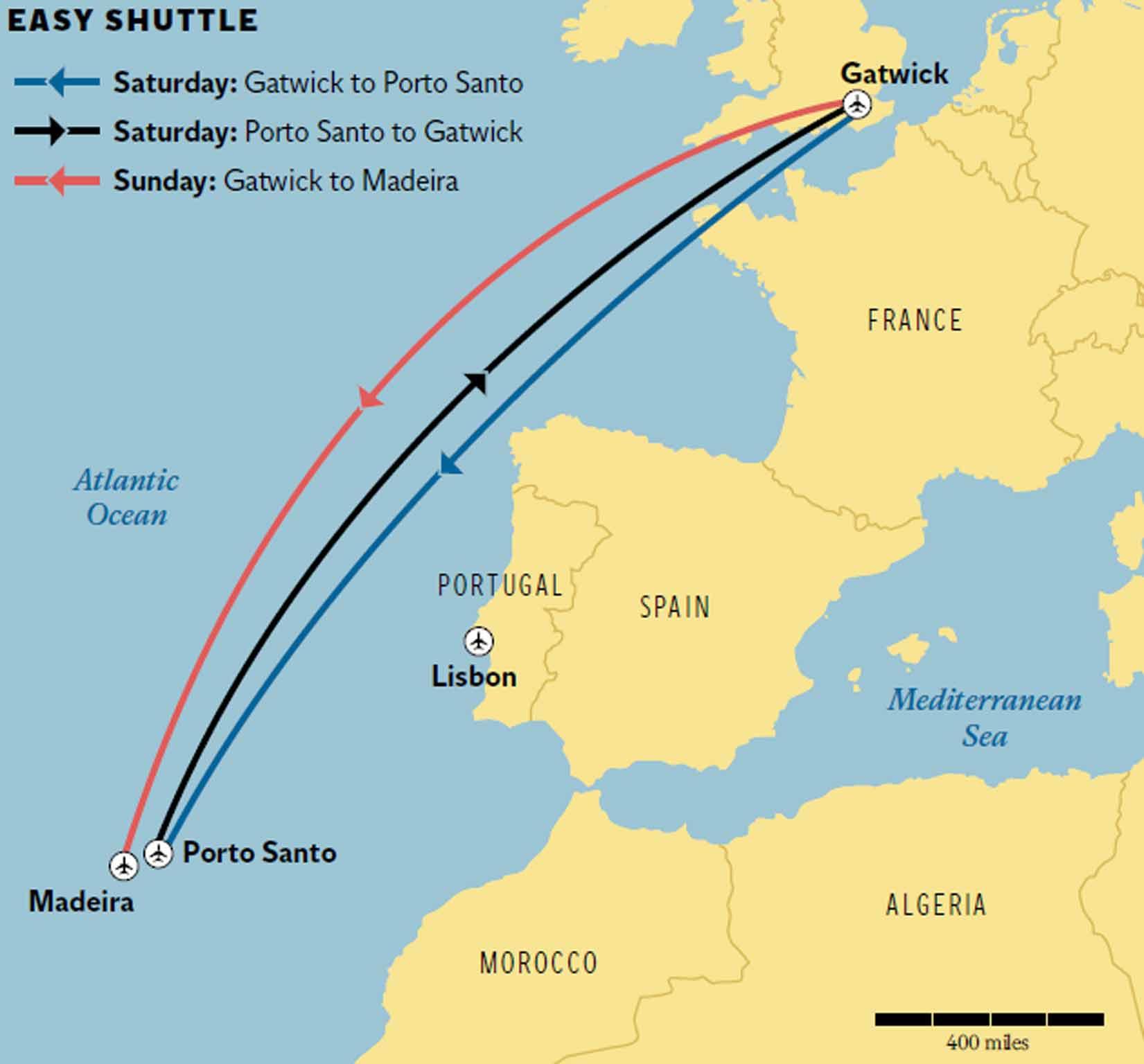Madeira mixup: Finding a Porto Santo in an Atlantic storm
The man who pays his way

Like pearls cut loose, Portugal's islands are scattered widely across the Atlantic. From the past possessions of Cape Verde off the African coast to the westernmost fragments of the Azores halfway to America. In the middle, the map is enlivened by the unidentical twins of Madeira and Porto Santo. The first comprises volcanic wreckage draped in lush vegetation and strewn with flowers; the second, a sandy slab of Sahara that Africa has somehow mislaid.
They stand about 30 miles apart, and are linked by air and sea – facts that will become relevant shortly.
Madeira has seen a surge in flights this summer, with both easyJet and British Airways adding services from Britain. Last Saturday, though, BA subtracted its new link from Gatwick. High winds were forecast for Madeira's notoriously tricky runway. BA's morning flight, 2780, stayed on the ground for a full 24 hours while grounded passengers sampled the joys of the Gatwick Premier Inn rather than sipping a chilled white port on the lawn at Reid's – the signature hotel in Madeira's capital, Funchal.
Those passengers booked on easyJet's afternoon flight on the same route were feeling more optimistic. Flight 5137 took off on time under the command of a jovial Canadian captain by the name of Peter Buckley. Half-an-hour from arrival, passenger Jonathan Richards was feeling jovial too. But then, he says, the pilot announced: "It's a little windy at Funchal and there's a plane in front of us going to land so we'll have to wait." A little later: "Unfortunately the wind which was supposed to lessen has increased in speed, so we have 45 minutes of holding fuel – then I'm going to put us down on a nearby island, Porto Santo, and we'll have a chat about what to do next."
Mr Richards picks up the story: "Eventually time ran out and he broke the news that we'd be landing 30 miles short of our destination to refuel and wait for the weather. Through the murk emerged Porto Santo – an island I've often thought about visiting, just not quite like this."
Diversionary tactics
All sorts of factors, from dwindling fuel to medical emergencies, can trigger diversions. Flights heading to the busiest runways in the world – at Heathrow and Gatwick – are particularly prone to diversion roulette, with passengers turning up anywhere from Bournemouth to Newcastle if a runway is closed. Over the years, I have discovered hidden and exotic corners of the globe such as Stephenville in Newfoundland, Guam in the north Pacific and Birmingham in the West Midlands (on a plane from Palma that was turned away from fogbound Manchester).
On Tuesday, London City airport came up with something different: a hole in the runway meant that thousands of departing passengers experienced Docklands doldrums as they waited for planes that were scattered to the four corners of the South-east: British Airways' passengers arriving from Amsterdam and Zurich got to enjoy the calm and tranquillity of Southend. People who had battled their way to Basel airport for the inhumanly early departure to "LCY" enjoyed a spin around Folkestone before touching down at Stansted, 30 miles from where they wanted to be – the same distance as Mr Richards and his fellow passengers in Porto Santo were from their final destination.
He takes up his tale: "The captain announced people from the island or anyone else who wanted to end their journey could do so. To his credit, he talked to everyone, and then left the plane to physically assist the baggage handlers."
The weather in Madeira failed to improve. A decision had to be made before the crew's maximum legal flying hours were exceded. Could the Airbus stay in Porto Santo and hop across to Madeira next day? No, says the airline, "the limited availability of hotel rooms" ruled this out. The nearest easyJet base, with plenty of hotels, was Lisbon – 600 miles away. But easyJet instructed the pilot to fly his passengers 1,500 miles back to the airport they had left seven hours earlier.
They touched down at Gatwick at 2am. In 11 hours, enough time to reach Los Angeles, the passengers had flown 3,000 miles and got nowhere. They were told to retrieve their bags and wait for a couple of hours before checking in again for a 6.30am second attempt – same gate, same plane, different crew. Mr Richards finally made it to the Madeira in time for Sunday lunch rather than Saturday dinner. But he was impressed with the way the problem had been handled: "Communication and customer care made it a great day out; easyJet were awesome."
Boomerang airline
The cost to easyJet in fuel alone was £12,000, plus wear and tear on the aircraft – notably its most valuable components, the engines. It would have been much cheaper (and less damaging environmentally) to hop across to Lisbon. But the crew would have needed a minimum of 12 hours' rest before attempting the return hop to Madeira. And with weather in the Atlantic so fickle, easyJet decided it needed maximum flexibility. So it was back to the airline's main base at Gatwick, where plenty of crew were available, even though it meant thousands of pounds were diverted from easyJet shareholders.
Subscribe to Independent Premium to bookmark this article
Want to bookmark your favourite articles and stories to read or reference later? Start your Independent Premium subscription today.

Join our commenting forum
Join thought-provoking conversations, follow other Independent readers and see their replies